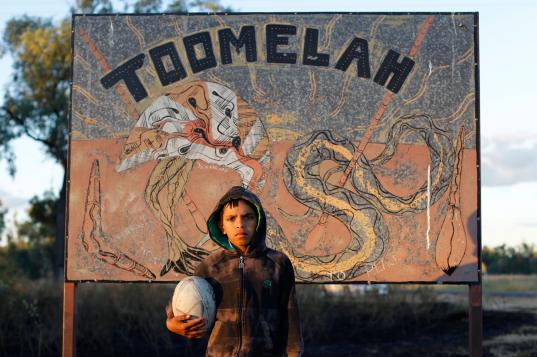
Still of film Toomelah (Ivan Sen, 2011, Australia) part of the Together, Alone – Indigenous Film Now series presented by Harvard Art Museums
Running from 5 February to 18 September 2016, Everywhen : The Eternal Present in Indigenous Art from Australia offers the following public educational and festive events:
Thursday 4 February 2016
5pm-10pm | Opening Celebrations
From 5pm, visitors will have an opportunity to view the exhibition. From 6pm to 7.30pm the Harvard Art Museums will present a discussion highlighting the show’s central themes of transformation, performance, seasonality, and remembrance. Stephen Gilchrist, Australian Studies Visiting Curator, will be in conversation with Vernon Ah Kee, who is among the artists featured in the exhibition. Lecture attendees are then invited to return to the galleries after the discussion, as well as to enjoy a reception in the Calderwood Courtyard.
Wednesdays 10, 24 Feb. – 9, 23 March – 6, 20 April and 4, 18, 25 May 2016
12:30pm | Curator’s Talk
Stephen Gilchrist, Australian Studies Visiting Curator, will give a gallery talk about the exhibition Everywhen: The Eternal Present in Indigenous Art from Australia.
Sundays 21, 28 Feb – 6, 13, 20, 27 March- 3, 10, 17 April 2016
Thursday 3 March (6pm)
1 pm | Together, Alone: Indigenous Film Now
This series—presented in conjunction with the special exhibition Everywhen: The Eternal Present in Indigenous Art from Australia—will highlight the contribution that Indigenous filmmakers have made and how they are reshaping cinematic representations. While Indigenous peoples from Australia have been portrayed in film since the beginning of the medium, it is only in the last two decades that Indigenous directors have taken control of the camera to tell their own stories in their own ways. In addition, non-Indigenous directors have had to re-examine how they tell Indigenous stories to ensure that they become true collaborations of meaningful exchange. Whether working independently or collaboratively, Indigenous peoples are taking ownership of their self-representation in documentary, musical, social realism, and avant-garde cinema.
The films are: Beneath Clouds (2002), Ten Canoes (2006), Art and Soul (2010), The Tracker (2002), Charlie’s Country (2013), Samson and Delilah (2009), Toomelah (2011).
Wednesday 23 March 2016
6 pm | Lecture by Michael D. Jackson : On the Road with Paddy Nelson Jupurrula
In the course of ethnographic fieldwork in central Australia in the 1990s, Michael D. Jackson, Distinguished Visiting Professor of World Religions at Harvard Divinity School, got to know Paddy Nelson Jupurrula, one of the pre-eminent Warlpiri artists of the Western Desert painting movement. Professor Jackson will share some of Jupurrula’s insights into a worldview that emphasizes metamorphic processes, phases, or passages rather than contrasting conditions, such as being and nothingness, life and death, presence and absence, subject and object. In describing and depicting the transformations through which all things pass, Warlpiri artists invoke gestation and birth, sexual intercourse, digestion and defecation, sleeping and waking, fullness and emptiness as basic ontological metaphors.
Tuesday 5 April 2016
6 pm | Artist Talk: Christian Thompson
Christian Thompson, who is among the artists featured in the special exhibition Everywhen: The Eternal Present in Indigenous Art from Australia, will discuss his paper “Creative Responses to Australian Material Culture in the Pitt Rivers Museum Collection: Parallels between Christian Thompson—We Bury Our Own and Fred Wilson—Mining The Museum.” He will also perform songs in Bidjara, an Indigenous Australian dialect.
The Australian-born, London-based artist creates works that explore notions of identity, cultural hybridity, and history, with a focus on sexuality, gender, and race. Formally trained as a sculptor, Thompson engages multiple mediums, such as photography, video, sculpture, performance, and sound. In his live performances and conceptual portraits, he inhabits a range of personas, achieved through handcrafted costumes and carefully orchestrated poses and backdrops. His works are held in major international and Australian collections. In 2010, he became the first Aboriginal Australian to be admitted to the University of Oxford, where he earned a doctorate in fine art.
SOURCE : Harvard Art Museums